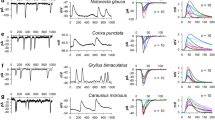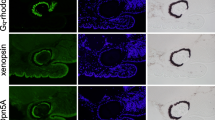Summary
Dipteran rhabdomeres are dielectric waveguides. Using dielectric waveguide theory an expression for the spectral sensitivity of retinula cells is derived. The spectral sensitivity of a retinula cell, S (A), depends strongly on the physical properties of the rhabdomere (diameter and refractive index) in addition to the spectral absorption of the photopigments. By correlating theory with existing experimental results we conclude that:
-
1.
The effect of containing photopigment within a rhabdom of small diameter is (a) to shift the visible absorption peak to lower wavelengths and (b) to increase the UV peak absorption relative to the visible peak. The smaller the diameter of the rhabdom the greater the effect (Fig. 8 and 9).
-
2.
The theoretical results (Fig. 10) for the spectral sensitivity,S (λ), of fly retinula cells are consistent with the single cell electrophysiology of Autrum and Burkhardt (1961) and Burkhardt (1962). The blue receptor type recorded by single cell electrophysiology is identified with rhabdomere number 7. The blue receptor is different from the green receptor type (rhabdomeres 1–6) because it has a smaller diameter not because of a different photopigment. The enormous measured UV sensitivity of the blue receptor type is due mainly to the waveguide effects caused by the small diameter of rhabdomere 7. Nevertheless, we conclude that in addition to a rhodopsin-like visible photopigment a separate UV photopigment is present in each rhabdomere. The spectral sensitivity of the photopigments consistent with these findings is shown as the dotted line in Fig. 10.
-
3.
Rhabdomere 7 acts like a UV colour filter for rhabdomere 8, since it is more distal and has a large UV absorption. Thus the yellow-green receptor type measured by single cell electrophysiology, which has a low UV sensitivity compared with the blue type, may be retinula cell 8.
-
4.
Spectral sensitivity curves inferred by optomotor reactions cannot be identified with retinula cells 1–6 in isolation of cells 7 and 8 and vice versa. Micro-spectrophotometric determination ofS (λ) is subject to methodological errors which render its reliability suspect. In the author's opinion, the intracellular recordings of Autrum and Burkhardt (1961) and Burkhardt (1962) represent the correctS (λ) curves for fly retinula cells.
Similar content being viewed by others
References
Autrum, H., Burkhardt, D.: Spectral sensitivity of single visual cells. Nature (Lond.)190, 639 (1961).
Born, M., Wolf, E.: Principles of optics, p. 161, 435. New York: Pergamon Press 1965.
Boschek, C. B.: On the fine structure of the peripheral retina and lamina ganglionaris of the fly,Musca domestica. Z. Zellforsch.118, 369–409 (1971).
Burkhardt, D.: Spectral sensitivity and other response characteristics of single visual cells in the arthropod eye. Symp. Soc. exp. Biol.16, 86–109 (1962).
Burkhardt, D.: Colour discrimination in insects. Advanc. Insect Physiol.2, 131–173 (1964).
Dartnall, H. J. A.: In: The eye (edited by H. Davson), vol. 2, chapt. 17. London: Academic Press 1962.
Eckert, H.: Die spektrale Empfindlichkeit der Rezeptorsysteme im Komplexauge vonMusca domestica L. Kybernetik9, 145–151 (1971).
Franceschini, N., Kirschfeld, K.: Etude optiquein vivo des éléments photorécepteurs dans l'oeil composé deDrosophila. Kybernetik81, 1–13 (1971).
Goldsmith, T. H.: The colour vision in insects. In: Light and life, W. D. McElroy and B. Glass, eds. Baltimore: John Hopkins Press 1961.
Kirschfeld, K.: In: Processing of optical data by organisms and machines (edited by W. Eeichardt), p. 116–126; 144–163. London: Academic Press 1969.
Langer, H., Thorell, B.: In: The functional organisation of the eye (edited by C. G. Bernhard). London: Pergamon Press 1966a.
Langer, H., Thorell, B.: Microspectrophotometry of single rhabdomeres in the insect eye. Exp. Cell Bes.41, 673–677 (1966b).
Liebman, P. A.: Microspectrophotometry of photoreceptbrs. In: Handbook of sensory physiology, vol. VII (edited by H. J. Dartnall). Berlin-Heidelberg-New York: Springer 1972.
McCann, D., Arnett, D. W.: Spectral and polarisation sensitivity of the dipteran visual system. J. gen. Physiol.59, 534–558 (1972).
Melamed, J., Trujillo-Cenóz, O.: The fine structure of the central cells in the ommatidia of Diptera. J. Ultrastruct. Res.21, 313–334 (1968).
Menzel, R.: Colour Receptors in insects. In: The compound eye and vision of insects, ed. G. A. Horridge. Oxford: University Press 1973.
Seitz, G.: Der Strahlengang im Appositionsauge vonCalliphora erythrocephala. Z. Vergl. Physiol.59, 205–231 (1968).
Snitzer, E.: Cylindrical dielectric waveguide modes. J. opt. Soc. Amer.51, 491–498 (1961).
Snyder, A. W.: Asymptotic expressions for eigenfunctions and eigenvalues of a dielectric or optical waveguide. IEEE trans. on Microwave theory and techniques17, 1130–1138 (1969a).
Snyder, A. W.: Excitation and scattering of modes on a dielectric or optical fiber. IEEE trans. on Microwave theory and techniques17, 1138–1144 (1969b).
Snyder, A. W.: Power loss on optical fibers. Proc. IEEE60, 757–758 (1972).
Snyder, A. W.: Optical properties of invertebrate photoreceptors. In: The compound eye and vision of insects, ed. G. A. Horridge. Oxford: University Press 1973a.
Snyder, A. W.: Polarization sensitivity of individual retinula cells. J. comp. Physiol.83, 331–360 (1973b).
Snyder, A. W., Miller, W. H.: Fly colour vision. Vision Res.12, 1389–1396 (1972).
Snyder, A. W., Pask, C.: Light absorption in the bee photoreceptor. J. opt. Soc. Amer.62, 998–1008 (1972).
Snyder, A. W., Pask, C.: Absorption in conical optical fibers. J. opt. Soc. Amer. in press (1973).
Snyder, A. W., Richmond, P.: Effect of anomalous dispersion on visual photopigments. J. opt. Soc. Amer.62, 1278–1285 (1972).
Snyder, A. W., Richmond, P.: Anomalous dispersion in visual photoreceptors. Vision Res.12, 511–515 (1973).
Trujillo-Cenóz, O., Melamed, J.: In: The functional organisation of the compound eye (edited by C. G. Bernhard). London: Pergamon Press 1966.
Wada, S.: Ein spezieller Rhabdomerentyp im Fliegenauge. Experientia27, 1237–1238 (1971).
Author information
Authors and Affiliations
Rights and permissions
About this article
Cite this article
Snyder, A.W., Pask, C. Spectral sensitivity of dipteran retinula cells. J. Comp. Physiol. 84, 59–76 (1973). https://doi.org/10.1007/BF00694147
Received:
Issue Date:
DOI: https://doi.org/10.1007/BF00694147




